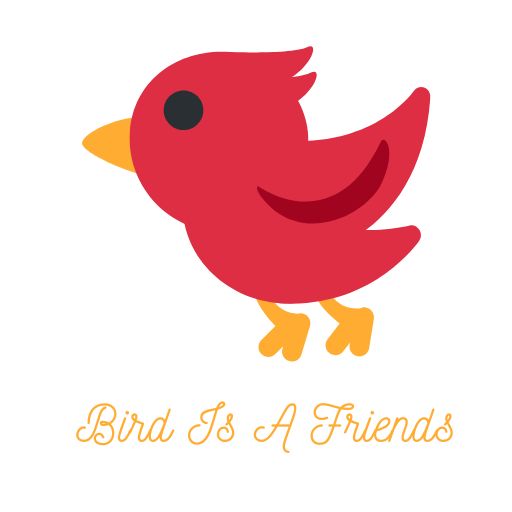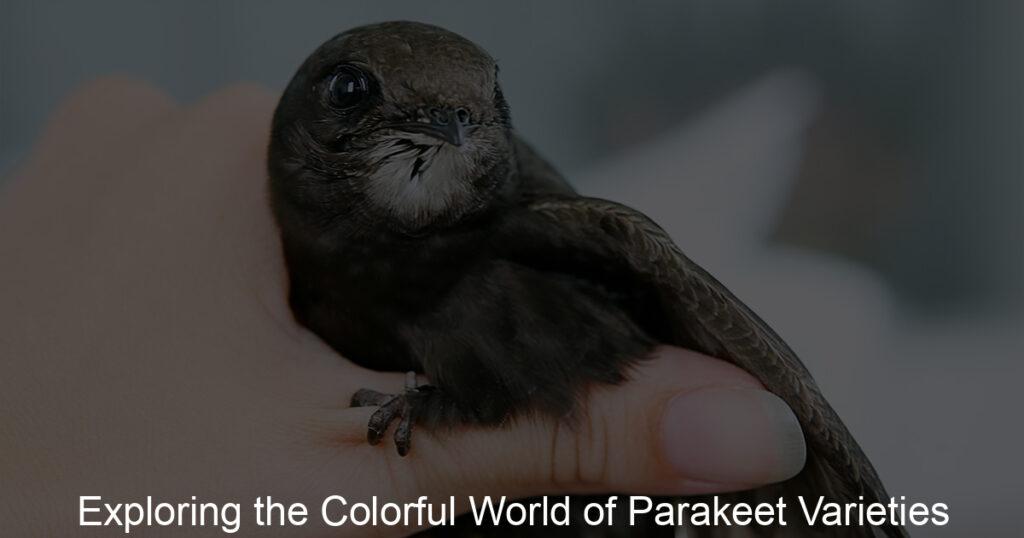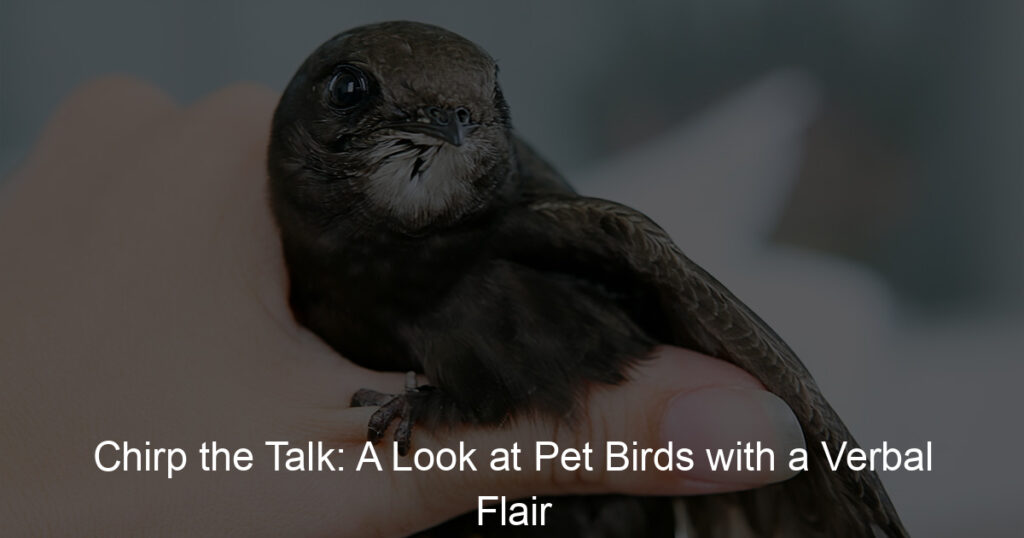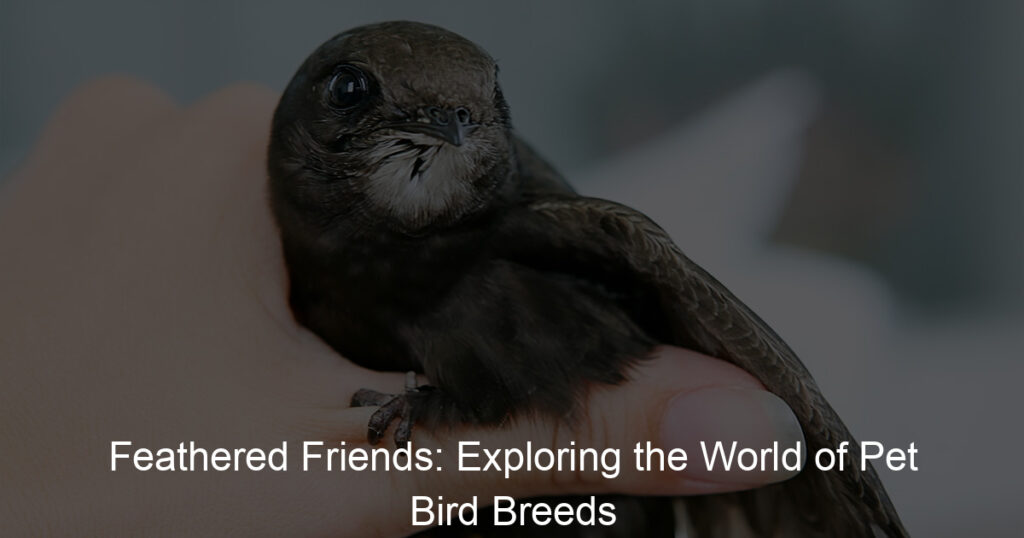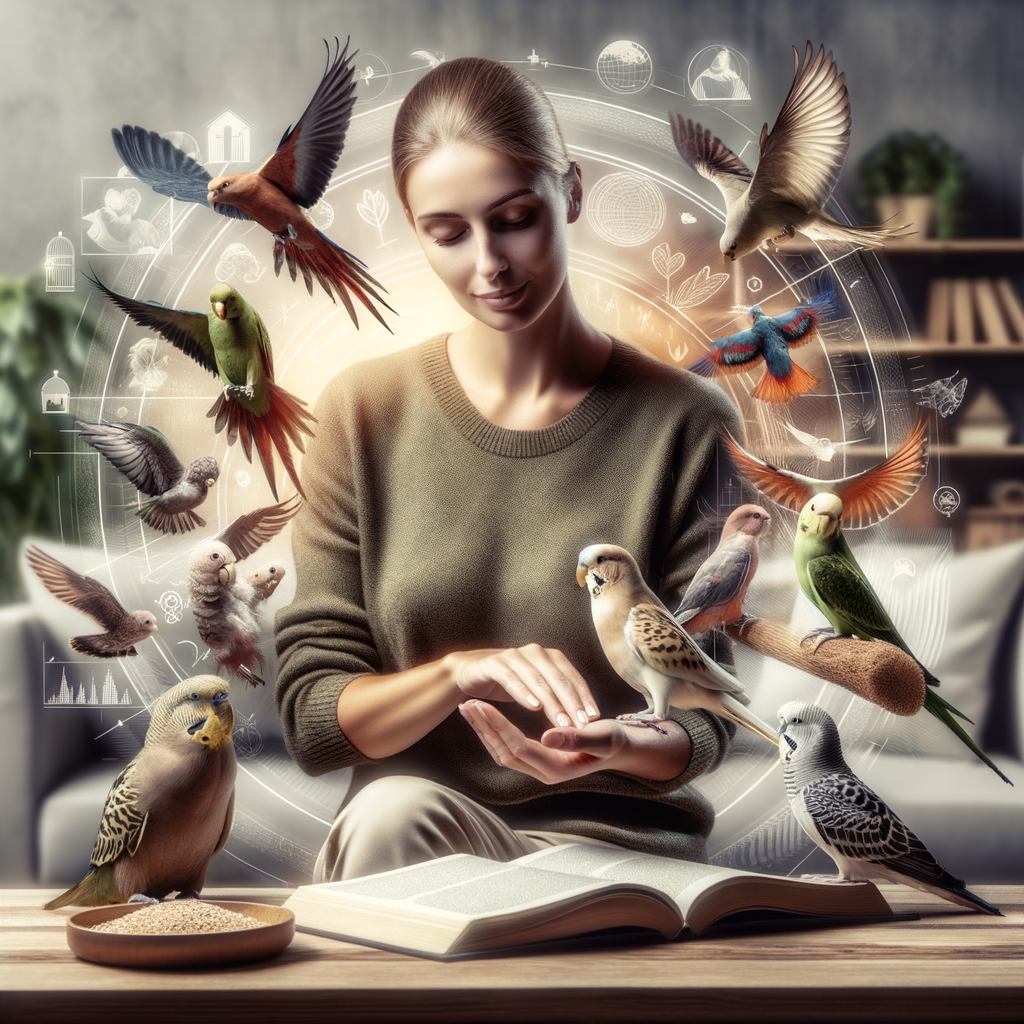
Introduction to Bird Bonding
Having a bird as a pet can be a delightful experience. These feathered friends are not just beautiful to look at, but they can also provide a unique form of companionship. However, to fully enjoy the benefits of having a bird as a pet, it’s crucial to understand and engage in bird bonding. This process involves creating a strong, positive relationship with your bird, which can significantly impact their behavior and overall well-being.
- Understanding the Importance of Bonding with Your Feathered Friends
- The Role of Companionship in Bird Behavior
Building a bond with your bird is not just about having a pet that will sing or talk on command. It’s about creating a relationship based on trust and mutual respect. Birds are intelligent creatures, and they can form deep emotional connections with their human caregivers. When you bond with your bird, you’re not just gaining a pet; you’re gaining a friend.
Companionship plays a significant role in bird behavior. Birds are social creatures by nature, and they thrive in environments where they feel loved and secure. When a bird feels bonded with its caregiver, it’s more likely to exhibit positive behaviors such as singing, playing, and interacting. On the other hand, a bird that feels neglected or scared may exhibit negative behaviors such as biting, screaming, or feather plucking.
In the following sections, we’ll delve deeper into understanding bird behavior, building a relationship with birds, and how to care for your pet bird to foster stronger bonding. We’ll also share some inspiring case studies of successful bird bonding stories. By the end of this article, you’ll have a comprehensive understanding of the joy of bird companionship and how to achieve it.
Understanding Bird Behavior
When it comes to understanding our feathered friends, it’s crucial to grasp their unique ways of communication. Birds have a language of their own, and learning to decode it can be a fascinating journey. Let’s delve into the world of bird communication.
Decoding Bird Communication
Bird communication is a complex system that involves a combination of vocal sounds and body language. By recognizing different bird sounds and interpreting their body language, we can gain a deeper understanding of their behavior and needs.
- Recognizing different bird sounds and their meanings
- Interpreting bird body language
Birds use a variety of sounds to communicate. These can range from simple chirps to complex songs. For instance, a bird’s song can be a territorial claim, a mating call, or a warning signal. A series of rapid chirps could indicate excitement or distress. It’s important to listen carefully and observe the context to understand the meaning behind these sounds.
Bird body language can provide valuable insights into their mood and health. For example, a bird that is fluffed up and sitting quietly might be feeling unwell. On the other hand, a bird that is preening and chirping happily is likely content. Observing their body language in combination with their sounds can give us a more complete picture of their behavior.
In conclusion, understanding bird behavior is a matter of careful observation and patience. By learning to decode their sounds and body language, we can build a stronger bond with our avian companions and ensure their well-being.
Understanding Bird Behavior Patterns
Just like humans, birds have their own unique behavior patterns. By understanding these patterns, you can better understand your pet bird’s needs and emotions. In this section, we will explore common behaviors in pet birds and what these behaviors can indicate about your bird’s health or mood.
- Common behaviors in pet birds
- Preening: This is when your bird uses its beak to clean and arrange its feathers. It’s a normal behavior that helps keep their feathers in good condition.
- Singing or Talking: Many birds are known for their vocal abilities. They may sing, talk, or make other sounds as a way of communicating.
- Foraging: In the wild, birds spend a lot of time searching for food. You might see your pet bird exhibit this behavior by digging or pecking around its cage.
- Bathing: Birds often enjoy bathing to keep their feathers clean. They may splash around in a water dish or fluff their feathers under a mist of water.
- What certain behaviors can indicate about your bird’s health or mood
- Feather Plucking: If your bird is plucking or chewing its feathers, it could be a sign of stress, boredom, or a medical issue.
- Loss of Appetite: If your bird is not eating as much as usual, it could be a sign of illness. It’s important to consult with a vet if you notice this behavior.
- Aggression: If your bird is acting aggressively, it could be a sign that it’s feeling threatened or stressed.
- Lethargy: If your bird is less active than usual, it could be a sign of illness. Again, it’s important to consult with a vet if you notice this behavior.
There are several common behaviors that you might observe in your pet bird. These include:
While many bird behaviors are normal, some can indicate that your bird is not feeling well or is stressed. Here are a few behaviors to watch out for:
Understanding your bird’s behavior patterns can help you provide the best care for your feathered friend. Remember, if you notice any drastic changes in your bird’s behavior, it’s always a good idea to consult with a vet.
Building Relationship with Birds
Building a relationship with your bird is a rewarding experience. It requires patience, understanding, and a lot of love. In this section, we will discuss how to build trust with your bird, which is the foundation of a strong bond.
Building Trust with Birds
Trust is the cornerstone of any relationship, including the one with your feathered friend. Here are some steps to help you build trust with your bird.
- How to approach your bird without causing fear or stress
- Steps to gradually build trust with your bird
- Start by spending time near your bird’s cage. This allows your bird to observe you and get used to your presence.
- Once your bird seems comfortable with your presence, you can start to interact with them. Offer treats from your hand and speak to them in a soft, soothing voice.
- Gradually increase the amount of time you spend interacting with your bird. Remember to always be gentle and patient.
- Once your bird is comfortable with you, you can start to train them using positive reinforcement techniques. This not only strengthens your bond but also stimulates your bird mentally.
Approaching your bird in a non-threatening manner is crucial. Avoid sudden movements and loud noises, as these can scare your bird. Instead, move slowly and speak softly. Remember that your bird is a prey animal in the wild, and it’s natural for them to be wary of larger creatures. It’s essential to respect their space and let them get used to your presence gradually.
Building trust with your bird doesn’t happen overnight. It’s a process that requires patience and consistency. Here are some steps to help you along the way:
Remember, every bird is unique and will respond differently to these steps. What’s important is to be patient, consistent, and understanding. With time and effort, you can build a strong, trusting relationship with your bird.
Bird Training for Bonding
Training your bird is not just about teaching them tricks. It’s also a great way to strengthen your bond with them. By using the right methods, you can build a relationship based on trust and mutual respect. Let’s explore some of these techniques.
- Using Positive Reinforcement in Bird Training
- Training Exercises to Strengthen Your Bond with Your Bird
Positive reinforcement is a powerful tool for bird training. It involves rewarding your bird for desirable behavior, which encourages them to repeat it. This could be a treat, a favorite toy, or even a simple praise. It’s important to reward your bird immediately after they perform the desired behavior, so they can make the connection between their action and the reward.
For example, if you’re teaching your bird to step up onto your finger, you might give them a treat each time they do it correctly. Over time, they’ll start to associate stepping up with getting a treat, and they’ll be more likely to do it on command.
Training exercises can also help to strengthen your bond with your bird. These exercises should be fun and engaging for your bird, and they should also give you the opportunity to interact with them in a positive way.
One simple exercise is the “step up” command, where you teach your bird to step onto your finger on command. This exercise not only teaches your bird to trust you, but it also gives you a way to safely handle them.
Another exercise is the “target training”, where you teach your bird to touch a target (like a stick or a toy) with their beak. This can be a fun game for your bird, and it can also help you to guide their movements without having to touch them.
Remember, patience is key when training your bird. It may take time for them to learn new behaviors, and that’s okay. The most important thing is that you’re spending quality time together and building a strong, loving bond.
Pet Bird Care for Stronger Bonding
When it comes to bonding with your pet bird, creating a bird-friendly environment is a crucial step. This involves setting up a comfortable and stimulating cage and providing opportunities for your bird to explore and play.
Creating a Bird-Friendly Environment
Creating a bird-friendly environment is not just about physical comfort, but also about mental stimulation. Here are some key steps you can take:
- Setting up a comfortable and stimulating cage for your bird
- Providing opportunities for your bird to explore and play
Firstly, the size of the cage matters. It should be spacious enough for your bird to move around freely. The cage should also have plenty of perches at different heights and angles. This will encourage your bird to climb and exercise. Toys are another essential part of a stimulating cage environment. Opt for a variety of toys that engage different senses – visual, auditory, and tactile. Remember to rotate the toys regularly to keep the environment fresh and exciting.
Just like humans, birds need change and stimulation. Allow your bird to spend time outside the cage in a safe, bird-proof area. This could be a dedicated bird room or a supervised area in your living room. Provide toys and perches in this area too. Exploring a new environment can be a great mental workout for your bird. It also gives them a chance to stretch their wings and fly, which is essential for their physical health.
Remember, a bird-friendly environment is a stepping stone to a stronger bond with your pet bird. It shows your bird that you understand its needs and care about its well-being. This can go a long way in building trust and forming a deep, lasting bond.
Nutrition and Health Care
When it comes to bonding with your pet bird, providing proper nutrition and health care is of utmost importance. These aspects not only ensure the well-being of your feathered friend but also strengthen your bond with them.
-
Providing a Balanced Diet for Your Bird
A balanced diet is crucial for your bird’s health. It should include a variety of foods, such as seeds, fruits, vegetables, and bird-safe grains. Remember, each bird species has unique dietary needs. For instance, parrots enjoy fruits and nuts, while canaries prefer seeds.
It’s also important to provide fresh water daily. Avoid giving your bird foods that are harmful to them, like chocolate, avocado, and caffeine. A balanced diet will keep your bird healthy, active, and happy, which is key to building a strong bond.
-
Regular Health Checks and Common Health Issues in Pet Birds
Regular health checks are essential in detecting any potential health issues early. You should observe your bird daily for any changes in behavior, eating habits, or appearance. If you notice anything unusual, it’s best to consult a vet immediately.
Common health issues in pet birds include feather plucking, respiratory problems, and obesity. By being aware of these issues, you can take preventative measures and seek timely treatment if needed. Remember, a healthy bird is a happy bird, and a happy bird makes for a stronger bond.
| Key Points | Details |
|---|---|
| Providing a Balanced Diet | Include a variety of seeds, fruits, vegetables, and bird-safe grains. Avoid harmful foods like chocolate, avocado, and caffeine. |
| Regular Health Checks | Observe your bird daily for any changes in behavior, eating habits, or appearance. Consult a vet if you notice anything unusual. |
| Common Health Issues | Feather plucking, respiratory problems, and obesity are common in pet birds. Awareness and preventative measures can help maintain your bird’s health. |
Case Studies: Successful Bird Bonding Stories
Now that we have discussed the basics of bird bonding, let’s look at some real-life examples. These stories highlight the power of patience, understanding, and love in creating strong bonds with our feathered friends.
- Story 1: Building Trust with a Rescue Bird
- Story 2: Overcoming Behavioral Issues through Bonding and Training
Meet Jenny and her rescue bird, Charlie. Charlie, a beautiful African Grey parrot, had a rough start in life. He was rescued from a neglectful home, and as a result, he was initially very wary of humans. Jenny knew that building trust with Charlie would take time and patience.
She started by spending time near Charlie’s cage, talking softly to him and offering him his favorite treats. Gradually, Charlie began to respond to Jenny’s voice and accept treats from her hand. After several weeks, Charlie allowed Jenny to gently stroke his feathers. It was a significant milestone in their bonding process.
Today, Charlie and Jenny share a strong bond. Charlie is no longer the scared, distrustful bird he once was. He now enjoys cuddles and playtime with Jenny, demonstrating the power of patience and love in building trust with a rescue bird.
Our second story features Tom and his cockatoo, Bella. Bella was known for her loud squawking and destructive behavior. Tom was at his wit’s end, not knowing how to manage Bella’s behavior.
Tom decided to seek help from a professional bird trainer. The trainer explained that Bella’s behavior was a cry for attention and suggested that Tom spend more quality time with Bella. He also taught Tom some simple training techniques to manage Bella’s behavior.
Tom followed the trainer’s advice and started spending more time with Bella. He also used the training techniques to teach Bella to channel her energy into more positive behaviors. Over time, Bella’s behavior improved significantly. She became calmer and more affectionate towards Tom.
This story shows how bonding and training can help overcome behavioral issues in birds. It also highlights the importance of understanding bird behavior and providing them with the attention and stimulation they need.
In conclusion, these stories demonstrate that with patience, understanding, and proper care, it is possible to build strong bonds with our feathered friends. Whether you are dealing with a rescue bird or a bird with behavioral issues, remember that every bird is unique and requires a personalized approach to bonding and training.
Conclusion: The Joy of Bird Companionship
As we come to the end of this enlightening journey, let’s take a moment to reflect on the beauty and joy that bird companionship brings into our lives. The bond between humans and birds is a unique one, filled with mutual respect, understanding, and deep connection.
- Recap of the importance of building a deep connection with your bird
- Final thoughts on the rewarding journey of bird bonding
Throughout this article, we have emphasized the importance of building a deep connection with your bird. This connection is not just about providing food and shelter; it’s about understanding their behavior, their needs, and their emotions. It’s about spending quality time with them, engaging in interactive play, and creating a safe and comfortable environment for them. This deep connection is what transforms a bird from a pet into a companion, a friend, and a member of the family.
The journey of bird bonding is a rewarding one, filled with moments of joy, laughter, and mutual understanding. It’s a journey that teaches us patience, empathy, and the beauty of non-verbal communication. It’s a journey that brings us closer to nature and helps us appreciate the simple pleasures of life. As we conclude, remember that every bird has its own personality and its own unique way of expressing love and affection. Embrace these differences, cherish every moment, and enjoy the rewarding journey of bird companionship.
In conclusion, bird companionship is not just about owning a pet; it’s about building a deep, meaningful relationship with a creature that’s as unique and special as you are. It’s a journey filled with joy, love, and mutual respect. So, embark on this journey with an open heart and an open mind, and experience the joy of bird companionship.
